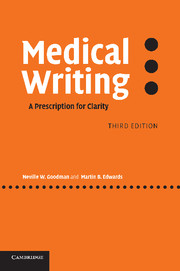Book contents
- Frontmatter
- Contents
- Preface to the first edition
- Preface to the third edition
- Acknowledgements
- PART I PROBLEM: THE ILLNESS
- PART II SOLUTION: SYMPTOMATIC RELIEF
- 3 Guidelines to clearer writing
- 4 Is there a better word?
- 5 Superfluous words
- 6 Imprecise words and phrases
- 7 Superfluous phrases
- 8 Trouble with short words
- 9 Use of the passive voice
- 10 Consistency: number and tenses
- 11 Circumlocution, metaphor and cliché
- 12 Word order and pronouns
- 13 Punctuation
- 14 Constructing sentences
- 15 Drawing clear graphs
- PART III PRACTICE: RECUPERATION
- Appendix: examples to rewrite
- References and further reading
- Index
10 - Consistency: number and tenses
Published online by Cambridge University Press: 23 November 2009
- Frontmatter
- Contents
- Preface to the first edition
- Preface to the third edition
- Acknowledgements
- PART I PROBLEM: THE ILLNESS
- PART II SOLUTION: SYMPTOMATIC RELIEF
- 3 Guidelines to clearer writing
- 4 Is there a better word?
- 5 Superfluous words
- 6 Imprecise words and phrases
- 7 Superfluous phrases
- 8 Trouble with short words
- 9 Use of the passive voice
- 10 Consistency: number and tenses
- 11 Circumlocution, metaphor and cliché
- 12 Word order and pronouns
- 13 Punctuation
- 14 Constructing sentences
- 15 Drawing clear graphs
- PART III PRACTICE: RECUPERATION
- Appendix: examples to rewrite
- References and further reading
- Index
Summary
Number: singular or plural?
Errors in which singular subjects govern plural verbs, or vice versa, are examples of what grammarians refer to as errors of concord. Concord – agreement – between subject and verb is the most important type. Mistakes occur most commonly with either…or, neither…nor, none, in lists, and with collective nouns (particularly when the noun is separated from the verb by a long clause). The error that many people seem to know about, but that is the least important, is the one made with the word DATA.
EITHER…OR, NEITHER…NOR, EACH
In Either Mr A is a liar or Mrs B is psychotic the verb is repeated and there is no confusion: the verb is singular. It is also singular if one or the other is the subject of the same verb: Either Mr A or Mrs B is psychotic.
Neither thiopental or methohexital are ideal induction agents.
Neither one nor (either links with or; neither with nor) the other is an ideal induction agent. These constructions cannot be applied to more than two choices.
When one of the choices is singular and the other plural, write the plural noun second: Neither the doctor nor the nurses are responsible…. The plural noun then governs the verb by the principle of proximity.
In speech, the plural is more natural when either…or or neither…nor is used.
Each implies a consideration of things taken one at a time and is singular: Each patient was asked….
- Type
- Chapter
- Information
- Medical WritingA Prescription for Clarity, pp. 145 - 151Publisher: Cambridge University PressPrint publication year: 2006



